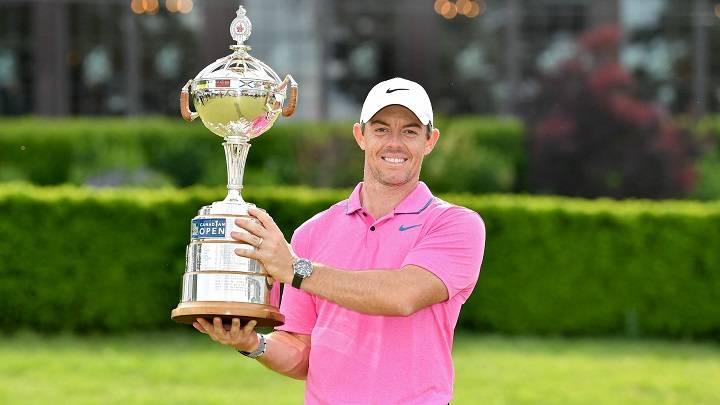You searched for Canadian Open payout because you want clarity. Simple. Humans. Useful. What’s the purse? How much does the winner take home? How deep does the money run, and what happens with ties? Let’s make it easy. We’ll walk through the standard PGA Tour payout structure, show you quick math to estimate any year’s purse, explain caddie shares and taxes, and give you a fan-friendly way to read the leaderboard in money terms. By the end, you’ll know exactly how a Canadian Open payout is built—and how to calculate it in seconds the next time the purse updates.
The Quick Answer (TL;DR for Payout Hunters)
The Canadian Open payout follows the PGA Tour’s standard distribution: the winner receives 18% of the posted purse, with the rest paid out on a descending scale through the field. If the purse is, say, $9,000,000, the winner’s share is $1,620,000. Second place gets a little over 10% of the purse, third dips into the upper single digits, and so on, tapering steadily as you slide down the board. That’s the core truth—learn the 18%, and everything else is just percentages.
How the Purse Turns into Checks
The 18% rule for the winner
This is the anchor. Multiply the purse by 0.18. That’s the champion’s check. Fast, clean, repeatable.
The standardized table for everyone else
After first place, the PGA Tour uses a published percentage schedule. Second is ~10.9%, third ~6.9%, fourth ~4.9%, fifth ~4.1%, sixth ~3.8%, seventh ~3.55%, eighth ~3.30%, ninth ~3.10%, and tenth ~2.90%. From there, it glides downward in small steps through the top 70 and beyond (depending on the week’s format). You don’t need to memorize every rung—just hold the shape in your mind: big at the top, smooth and fair as it falls.
Why the structure matters
It makes Sundays honest. A birdie at 17 can jump two spots and swing six figures. The Canadian Open payout is as much drama as it is math.
An Illustrative Breakdown (Using a $9,000,000 Purse)
Let’s turn percentages into numbers so you can “see” the Canadian Open payout. If the purse were $9,000,000, the top slices look like this:
- 1st (18.0%) → $1,620,000
- 2nd (10.9%) → $981,000
- 3rd (6.9%) → $621,000
- 4th (4.9%) → $441,000
- 5th (4.1%) → $369,000
- 6th (3.8%) → $342,000
- 7th (3.55%) → $319,500
- 8th (3.30%) → $297,000
- 9th (3.10%) → $279,000
- 10th (2.90%) → $261,000
- 11th (2.70%) → $243,000
- 12th (2.50%) → $225,000
- 13th (2.30%) → $207,000
- 14th (2.10%) → $189,000
- 15th (1.90%) → $171,000
- 16th (1.78%) → $160,200
- 17th (1.66%) → $149,400
- 18th (1.54%) → $138,600
- 19th (1.46%) → $131,400
- 20th (1.38%) → $124,200
You get the idea. If the actual purse shifts up or down in a given year, just multiply these same percentages by the posted number. Math travels.
Ties, Playoffs and What Happens When Scores Match
Ties for non-first places
Add the payout for all tied positions and split evenly. If two players tie for second, combine 2nd and 3rd money, divide by two, and each player gets that amount.
Playoff for first place
A playoff decides the champion only. The winner takes the full 18%; the runner-up receives the standard second-place percentage. Everyone else still uses the tie-split method for their positions.
Amateurs on the board
Amateurs can finish anywhere on the leaderboard but don’t collect prize money. Pros below them slide up into the money slots as usual.
Cutlines, Field Sizes, and How Deep the Money Goes
The Canadian Open typically follows the standard 36-hole cut to low 65 and ties (formats can change, but this is the usual heartbeat). If you make the cut, you’re in the payout stream. Miss it, and you’re on the wrong side of the line. Limited-field or weather-affected weeks can tweak the number of paid spots, but the descending table still guides distribution.
Caddie Pay: The Quiet Percentage Behind Every Check
Caddies aren’t paid from the purse by rule; they’re paid by the player. Most agreements blend a weekly base with percentages tied to performance. A common framework (teams vary) looks like: a base fee for the week, a smaller percentage for made cuts, a larger one for top finishes, and the largest for wins. For a Canadian Open payout, a victory can transform a caddie’s season—because that private percentage scales off a big headline number. The last putt is heavy for two people, not one.
Taxes, Travel, Team, and Why “Take-Home” Is Lower
The winner’s check is not the money in a player’s pocket. Pros pay federal taxes, provincial/state or local taxes where applicable, and then cover the team around them—caddie, coach, physio, trainer, agent. Add travel, lodging, and time on the road. The point isn’t to dampen the payout glow; it’s to see the full picture. The Canadian Open payout is still significant. It’s just part of a business, not a lottery ticket.
Beyond Cash: Points, Perks and Career Gravity
Money is one reward. FedExCup points are another. High finishes at a national open move needle after needle: playoff seeding, invitation status for future events, world-ranking traction, and—most important for pros—the right to set a schedule instead of chasing one. That’s why you’ll hear the phrase “consolidate the break” in golf speak: after you win big one week, holding form and cashing points the next can define a season.
Pressure Economics: How Payout Shapes Sunday Strategy
Players don’t stare at spreadsheets mid-fairway. But they feel the math. A bold shot over water can be the difference between 6th and 2nd. A conservative play might protect a top-10 and the perks that come with it. The Canadian Open payout doesn’t force decisions; it tilts them. Hole locations, wind, lie, and leaderboard context finish the conversation.
How to Estimate Any Canadian Open Payout in 30 Seconds
- Find the purse. That’s your anchor number.
- Winner’s share = purse × 0.18. Write it down.
- Sketch the top 10 using the quick table above (10.9%, 6.9%, 4.9%, 4.1%, 3.8%, 3.55%, 3.30%, 3.10%, 2.90%).
- Apply tie math if positions are shared.
- Remember amateurs don’t take prize money. Shift the pro payouts up accordingly.
That’s enough to sound like an accountant at a watch party.
Two Quick Scenarios (So You Can Do It in Your Head)
Scenario A: Purse = $9,000,000
- Winner: $1,620,000
- Runner-up (10.9%): $981,000
- Third (6.9%): $621,000
- T-2 example: combine $981,000 and $621,000, then split → $801,000 each
Scenario B: Purse = $8,500,000
- Winner: $1,530,000
- The top 10 still follow the same percentages. Just multiply by $8.5M instead of $9M. The shape stays; only the numbers move.
Caddie Math, Gently Demystified
Imagine a win with a $1.62M check and a deal that pays a weekly base plus, say, a double-digit percentage for victories. That caddie payday quickly becomes life-changing. On a T-10, the number is smaller, but still real. The lesson: when the broadcast shows a caddie grinning wide on 18, they’re not just happy for art’s sake. The Canadian Open payout reaches both sides of the bag.
International Flavor: Currency and Travel
It’s the Canadian Open, so yes, you’ll see Canadian fans, Canadian partners, and often Canadian storylines—but the purse is posted in U.S. dollars on Tour sheets. Travel costs vary by home base, and some players bump expenses for international weeks. It’s all part of the calculus behind scheduling, rest, and where a player chooses to peak.
What Fans Should Watch for on Sunday
- The lead vs. the pack: One bogey can be a six-figure swing.
- Par-5s: Eagle looks are money machines.
- Pins on 16–18: Where the tournament tightens its grip.
- Body language: A player who trusts the putter can leap three spots in 20 minutes.
- The quiet top-10 race: Not every camera finds it, but it matters a ton for points and checks.
Common Questions, Warm Answers
Is the winner’s percentage always 18%?
For standard PGA Tour stroke-play events, yes. Special formats can differ, but 18% is the norm. If you remember nothing else about the Canadian Open payout, remember that.
How far down does the money go?
Deep. Typically into the 60s and 70s depending on field and cut. Make the weekend and you’re in line for a check.
Do amateurs ever reduce the pros’ money?
No. Amateurs don’t take prize money. Pros below them slide into the paid slots.
What if three players tie for second?
Add second-, third-, and fourth-place money, divide by three. Clean and fair.
Do caddies get a fixed cut of the purse?
There’s no Tour-mandated number. Most teams use a base plus performance percentages that escalate for top finishes and wins.
A One-Minute, Shareable Summary
The Canadian Open payout is a percentage ladder: winner gets 18%, second gets just over 10%, then the shares taper smoothly. Ties divide evenly across the tied slots. Amateurs don’t draw from the purse. Caddies are paid by players, not the Tour, usually via base + percentage. Taxes and team costs trim the headline number, but points and invites make a high finish worth more than cash alone. To estimate any year’s money, grab the purse, multiply by 0.18 for the champion, and apply the table for everyone else. That’s the whole system—transparent, repeatable, drama-friendly.
FAQs
How do I estimate the winner’s check without looking it up?
Multiply the posted purse by 0.18. That’s the champion’s share. Done.
What’s the fastest way to read the top 10 in dollars?
Keep the quick table in mind: 18%, 10.9%, 6.9%, 4.9%, 4.1%, 3.8%, 3.55%, 3.30%, 3.10%, 2.90%. Multiply each by the purse.
If a player withdraws after making the cut, do they get paid?
Policies vary by event specifics, but generally, payouts follow the Tour’s rules published for the week. The leaderboard and official sheets settle it.
Are there bonuses beyond the purse at the Canadian Open?
Players also chase FedExCup points, world-ranking impact, and often sponsor or season-long incentives written into their own contracts.
Does a playoff change anything about the money?
Only at the top. The playoff decides who gets the 18% winner’s share. Everyone else’s money is handled by the normal tie-split math.



